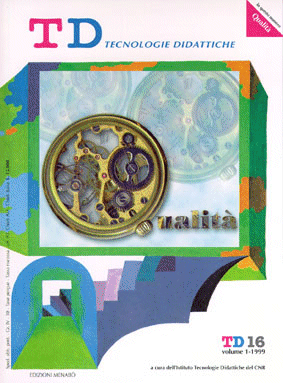Quality in distance education
Main Article Content
Abstract
Article Details
Authors who publish with this journal agree to the following terms:
- Authors retain copyright and grant the journal right of first publication with the work simultaneously licensed under a Creative Commons CC BY 4.0 Attribution 4.0 International License.
- Authors are able to enter into separate, additional contractual arrangements for the non-exclusive distribution of the journal's published version of the work (e.g., post it to an institutional repository or publish it in a book), with an acknowledgement of its initial publication in this journal.
- Authors are permitted and encouraged to post their work online (e.g., in institutional repositories or on their website) prior to and during the submission process, as it can lead to productive exchanges, as well as earlier and greater citation of published work (See The Effect of Open Access)
References
Barchecharth E. (1996), La progettazione dei sistemi formativi a distanza dal punto di vista economico, pedagogico e organizzativo, in M.A. Garrito (ed), La multimedialità nell’insegnamento a distanza, Garamond, Roma.
Barker B., Frisbie A., Patrick K. (1993), Broadening the definition of distance education in light of the new telecommunications technologies, in K. Harry, M. John e D. Keegan (eds), Distance education: new perspectives, Routledge, London.
Benigno V., Trentin G. (1999), La valutazione nella formazione a distanza, in Trentin G. (ed), Telematica e formazione a distanza: il caso Polaris, Franco Angeli, Milano.
Branson R.K., Buckner T. (1995), Quality applications to the classroom of tomorrow, Educational Technology, vol. 35, n. 3, pp. 19-22.
Briano R., Midoro V., e Trentin G. (1996), Aggiornamento in rete dei docenti sull’educazione ambientale, TD - Rivista di Tecnologie Didatti-che, n. 8/9 (1996), pp. 60-72, Edizioni Menabò, Ortona (CH).
Broad M.L., Newstrom J.W. (1992), Transfer of training, Reading, Addison- Wesley, MA.
Cukier J. (1997), Costbenefit analysis of telelearning: developing a methodology framework, Distance Education, vol. 18, n. 1, pp. 137-152.
Garrison D.R., Shale D. (1987), Mapping the boundaries of distance education: problems in defining the field, American Journal of Distance Education, vol. 1, n. 1, pp. 7-13.
Herman J.L. , Herman J.J. (1995), Total quality management (TQM) for education, Educational Technology, vol. 35, n. 3, pp. 14-18.
Keegan D. (1994), Principi di istruzione a distanza, La Nuova Italia, Firenze.
Kimmerling G. (1993), Gathering best practices, Training and Development, vol. 47, n. 3, pp. 28-36.
Kirkpatrick D.L. (1975), Techniques for evaluating training programs, Evaluating training programs, pp. 1-17, Alexandria, ASTD:VA.
Kirkwood A. (1998), New media mania: can information and communication technologies enhance the quality of open and distance learning?, Distance Education, vol. 19, n. 2, pp. 228- 241.
Laurillard D. (1993), Rethinking university teaching, Routledge, London.
Moore M. (1989), Three types of interaction, American Journal of Distance Education, vol. 3, n. 2, pp. 1-6.
Nipper S. (1989), Third generation distance learning and computer conferencing, in Mason R.D. e Kaye A.R. (eds), Mindweave: communication, computers and distance education, cap.5, Pergamon Press, Oxford.
Parsons T. (1979), Organisation and clients, Edizioni Merril.
Phillips J.J. (1998), The return-on-investment (ROI) process: issue and trends, Educational Technology, vol. 38, n. 4, pp. 7-14.
Rumble G. (1981), Economics and cost structures, in Kaye A. e Rumble G. (eds), Distance teaching for higher and adult education, Croom Helm, London.
Rumble G. (1982), The cost analysis of learning at a distance, Distance Education, vol. 4, n. 2, pp. 101- 131.
Short J. , Williams E., Christie B. (1976), The social psychology of telecommunications, John Wiley & Sons, Londra.
Trentin G. (1997), Logical communication structures for network-based education and tele-teaching, Educational Technology, vol. 37, n. 4, pp. 19-25.
Trentin G. (a cura di) (1999), Telematica e formazione a distanza: il caso Polaris, Franco Angeli, Milano.
Trentin G., Midoro V. (1996), A learning-lab where artificial intelligence meets hypermedia, Proceedings of the world conference Ed-media/Ed-telecom ’96, AACE, pp. 276- 282.

